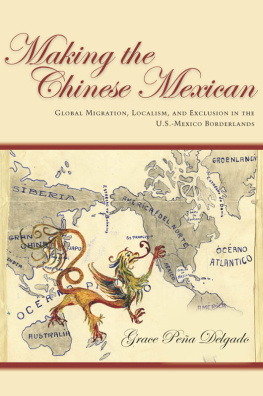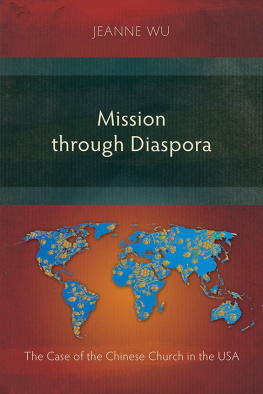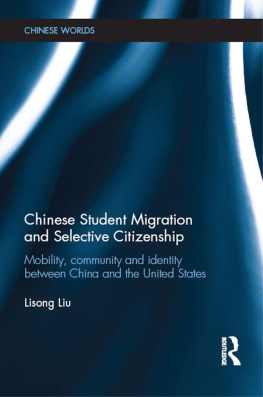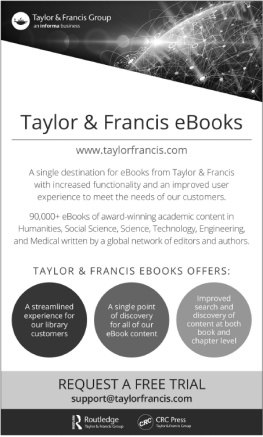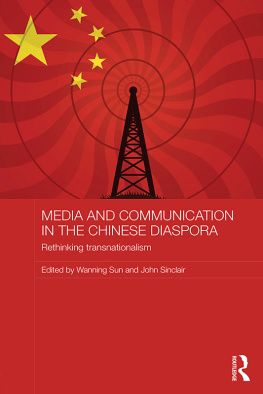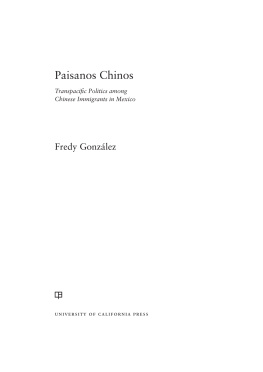Stanford University Press
Stanford, California
2012 by the Board of Trustees of the Leland Stanford Junior University. All rights reserved.
This book has been published with the assistance of The Pennsylvania State University.
No part of this book may be reproduced or transmitted in any form or by any means, electronic or mechanical, including photocopying and recording, or in any information storage or retrieval system without the prior written permission of Stanford University Press.
Printed in the United States of America on acid-free, archival-quality paper
Library of Congress Cataloging-in-Publication Data
Delgado, Grace, author.
Making the Chinese Mexican : global migration, localism, and exclusion in the U.S.-Mexico borderlands / Grace Pea Delgado.
pages cm
Includes bibliographical references and index.
ISBN 978-0-8047-7814-5 (cloth : alk. paper)
ISBN 978-0-8047-8371-2 (e-book)
1. Chinese--Mexican-American Border Region--Ethnic identity--History--20th century. 2. Immigrants--Cultural assimilation--Mexican-American Border Region--History--20th century. 3. Mexican-American Border Region--Race relations--Political aspects--History--20th century. 4. Mexico--Emigration and immigration--Government policy--History--20th century. 5. United States--Emigration and immigration--Government policy--History--20th century. I. Title.
F1392.C45D45 2012
305.800972'1--dc23 | 2011040196 |
Typeset by Bruce Lundquist in 10.5/12 Sabon
Acknowledgments
This book was made possible by the generosity and kindness of others. My first thanks go to friends and family members who sustained me through various phases of writing, researching, and rewriting. I cannot begin to express the critical role they played through this books rather long gestation period. I am deeply grateful for the loving-kindness of Mary McClanahan, Troy Johnson, the late Xiaolan Bao, Julie Rivera, Lauren Walton, Tom Magnetti, Sharon Corl, Peter Marshall, Lisa Kilpatrick and Keith Burch, Donnan Stoicovy, Ron Zimmerman, and Ron Mize. Each in his or her own way encouraged my scholarship with the perfect antidote to the tedium of writing and research. Special gratitude goes to the members of my family, who were patient and caring throughout: Mom, Sylvia, Alyssia, Rose, Scott, Kyle, Aaron, Carol, Jeff, and my twin brother, David. I have finally finished that paper.
In 2006 I threw caution to the wind and moved from southern California to central Pennsylvania to join the History Department at the Pennsylvania State University. I was hopeful that there a community of lively scholars, institutional resources, and some time away from teaching would help catapult my book to completion. And they did! What was most gratifyingand completely unanticipatedwas the manner in which my ideas grew, deepened, and in the end, came together. Matthew Restall read multiple drafts of the introduction and provided perceptive comment and encouragementand at a critical moment, opened doors for me at Stanford University Press when I was overwhelmed with tenure pressures. I am incredibly fortunate to have Matthew as my colleague. Philip Baldi, Cary Fraser, A. Gregg Roeber, Sally McMurry, Nan Woodruff, Tobias Brinkmann, Mrinalini Sinha, and Lori Ginzburg read parts of the manuscript at various stages of its development. I am thankful for their comments and their insights. With their usual enthusiasm, Amy Greenberg and Ronnie Po-chia Hsia read the entire manuscript. For their generous expenditure of time and their keen observations I am deeply grateful. Hongyan Chiang and Xinmin Lin checked and rechecked my Chinese translations and helped me navigate the murky waters of the Qing Dynasty and Republican-era calendars. Colleagues at other institutions have been equally gracious. Evelyn Hu-Dehart, Samuel Truett, K. Scott Wong, Erika Lee, Alexandra Minna Stern, and Alexis McCrossen read early parts of the manuscript and pushed me, however kindly, to clarify and develop my ideas. I am especially indebted to Katherine Benton-Cohen for her expeditious and painstaking (literally line-by-line) critique of the manuscript. Thank you, Katie, for a yeowomans work.
Equally critical in the shaping of this book were the contributions of several archivists in Mexico City, Tucson, Berkeley, Hermosillo, and Laguna Niguel. A few stand out as being especially dogged and wonderfully helpful. Paul Wormser, director of archives at the National Archives and Records Administrations Pacific Region, took particular interest in the project in its early stages. He led me to unculled documents on Chinese immigration and border crossing. Equally helpful was Rose Byrne, who at the time was an archivist at the Arizona Historical Society (AHS). To my great delight, she found source material on borderlands Chinese in unexpected places. Her tenacity as a researcher has enriched this book. Benjamn Alonso Rascn at the Archivo General del Estado de Sonora shared his deep knowledge of Sonoran history and the archives key archival holdings. In Mexico City, Jaime Vlez Storey guided me through the maze of rich archival material at the Archivo General de Mxico. Toward the end of the project, Jill McCleary, a librarian at AHS; Scott Cossel, from Library Technologies at the University of Arizona; and Chrystal Carpenter, an archivist at the University of Arizona Libraries, employed superhuman-like powers to secure permissions and images. Cartographer extraordinaire Erin Greb drew all the maps quickly and beautifully. I am so fortunate to have Erins creative and artistic contribution to the book. Generous subvention monies provided by the Pennsylvania State Universitys College of Liberal Arts, headed by Dean Susan Welch, made all the maps and images possible.
Late in the process I had the pleasure of meeting two energetic members of the Tucson Chinese Cultural Center (TCCC): Robin Blackwood, chair of the History Program; and Patsy Lee, president of the Tucson Chinese Association. Both Robin and Patsy embraced me and the book project with immediate enthusiasm and warmth. I was honored to be among a small group of academics and community scholars whom Robin and Patsy invited to speak at the TCCCs First Annual Chinese American Immigrant History Program in September 2010. My experience at the TCCC reminded me that writing history must never be a project of mere intellectual curiosity or indulgence. Wherever possible, social histories must be shared with communities of origin and, if plausible, coproduced in a meaningful and exacting manner. Along these same lines I want to acknowledge the generosity of Esther Don Tang. Known throughout Tucson for her long-standing record of social activism and intrepid spirit, Esther graciously allowed the use of a family photograph in this book. The stories about Esther and the Don Wah family are among several personal accounts that grant us a better understanding of how southern Arizona Chinese indelibly shaped the history of the U.S.-Mexico borderlands.
As this book neared its final stages, it benefited especially from the help of two friends, Barry Kernfeld and Mary McClanahan. Barrys talent as an editor and as a widely read scholar in many fields helped me clarify arguments and pay close attention to word choice. I always looked forward to receiving his penciled edits on paper recycled from his many books on jazz. I also treasure the friendship and editorial prowess of Mary McClanahan. During the dog days of completing this book, her wit and warmth inspired me to continue writing even when it meant returning to my office on cold winter nights. She kept me company, kept me fed, kept me laughing, and encouraged my sports-watching habit. With Mary I knew it was all possible.

